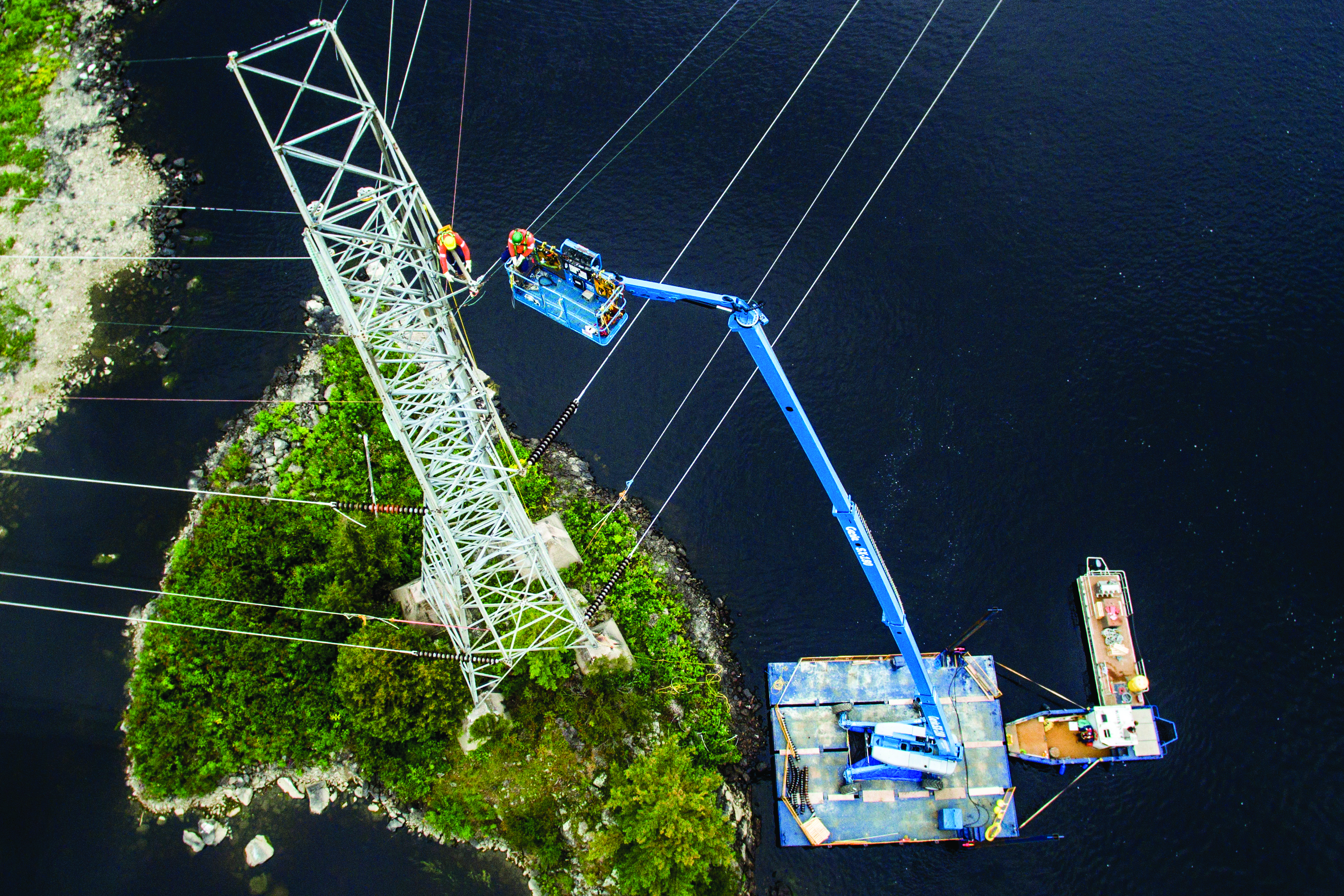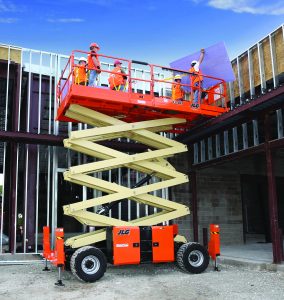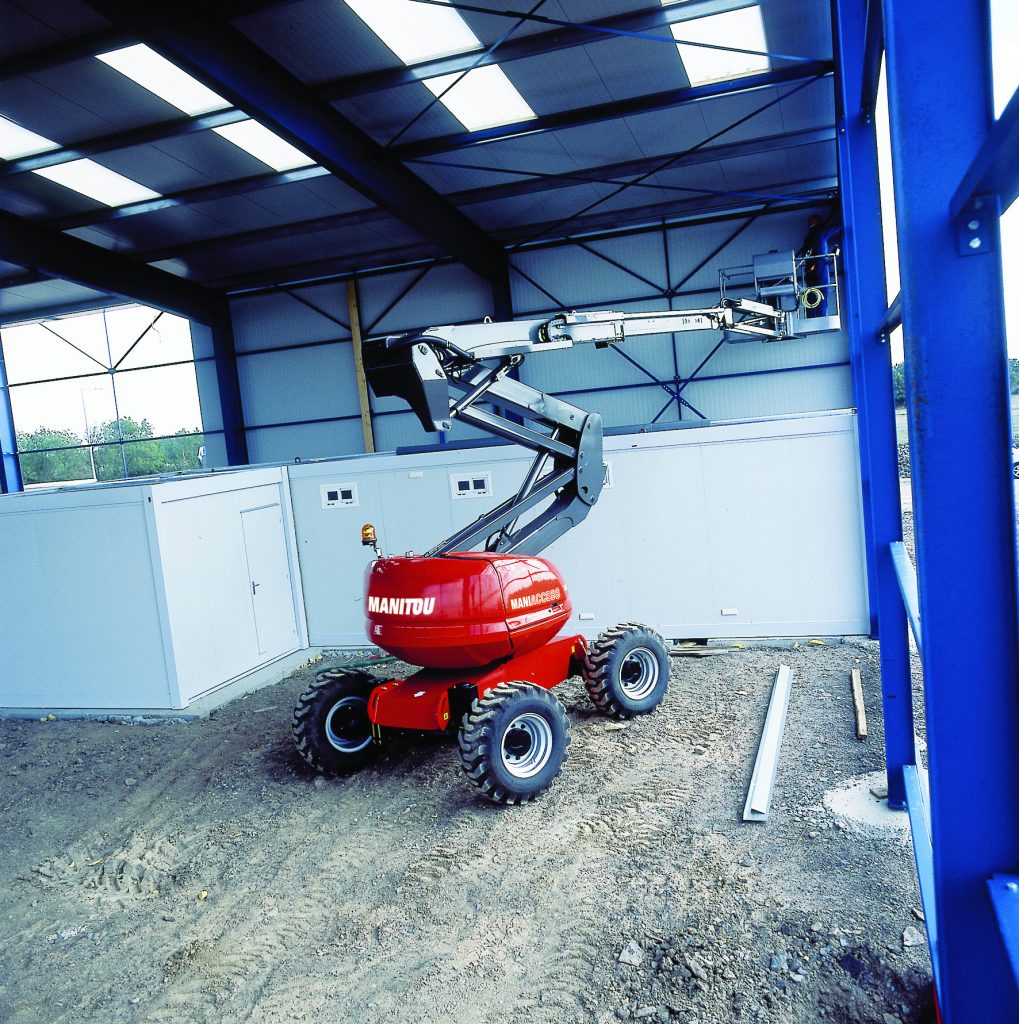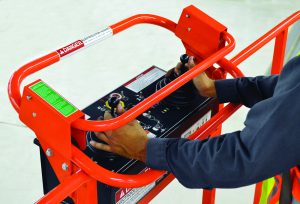
Elevating your game: New regulations and focus on safety redefining working from heights
By David Kennedy
Equipment
(PHOTO: Genie)
With their feet planted on an elevated work platform 40 metres (130 feet) above the Ottawa River, a pair of employees with marine construction contractor O.D.S. Marine set to work replacing a series of 10 high-voltage power lines on an isolated transmission tower last fall.
The maintenance project involved a complex set-up to reach the tower, which is situated on a small island just downriver from the Chenaux Generating Station. Rocky, rough terrain made setting up a lift on the island a non-starter, while other options such as a helicopter or jack-up barge carried significant costs.
To solve the problem, the contractor turned to a piece of equipment typically confined to dry land. It paired a sizable mobile elevated work platform (MEWP) with a four-section barge secured to the shoreline. After careful preparation, the Genie SX-180 was strapped into place on the barge and a crew of four – two on the elevated platform and two for marine support – set about replacing the power lines. Capable of extending 55 metres (180 feet) and performing a range of jib motions, the telescopic boom let the platform crew safely manoeuvre around the tower. It helped the team complete the job in two weeks, one week earlier than estimated, saving considerably on costs.
The novel approach to the hydro maintenance project is just one of the many ways contractors are reimagining how to carry out work in hard-to-reach places. Modern regulations and a new generation of technology are playing no small part in the steady advance of lifting equipment on job sites coast to coast.
A new standard

New standards governing mobile elevated work platforms (MEWPs) are designed to make working from heights safer for contractors. Equipment manufacturers are quickly adapting their scissors and booms in order to meet the new requirements (PHOTO: JLG)
Updated regulations from the Canadian Standards Association (CSA) and the American National Standards Institute (ANSI) are changing the rules of the game for scissor and boom lifts across North America.
Adam Hailey, the director of product management at equipment maker Genie, a unit of Terex Corp., says the fresh set of rules will establish a “new normal” for the industry and better align job sites in the U.S. and Canada with their European counterparts.
“The current standards have, for almost four decades, provided best practices for safe, reliable access to work at height,” he says, adding that modernizing the regulations will make features such as platform load limits and tilt sensing standard on new MEWPs.
Along with these major technological changes, the new standards will ban chain gates or other flexible gates as platform entrances and require an “indoor only” rating on small, less durable models.
“Our emphasis on safety begins at the design engineering phase and follows through manufacturing and test facilities.”
– Bill Dovey, JLG
For the contractors using the equipment, the CSA standards set new requirements for training, safe use and risk assessment, among other aspects. They also aim to rework common industry terminology, shelving the term aerial work platform (AWP) in favour of mobile elevated work platform.
Bill Dovey, senior product manager for Booms at JLG Industries, notes that while crews using newly-built MEWPs need to follow the new regulations, older models will continue to be governed by existing standards.
Pointing to enhanced features such as toe boards on scissor lifts and solid or foam-filled tires on all MEWPs, Dovey says product safety, along with meeting or exceeding regulations, are priorities for JLG. “Our emphasis on safety begins at the design engineering phase and follows through manufacturing and test facilities,” he says.
Manitou Group, the new kid on the block in the North American MEWP market, has also adapted its recently launched booms to meet the updated set of rules.
“For us, the new CSA and ANSI rules were not that big of a shock because that regulation is very close to the European regulations,” says Chris Mathijs, director of sales for Manitou, adding that many of the safety features new to North America have been in use in its European MEWPs for years. The company logged its first Canadian aerial sales at the end of last year, but has been active in other markets worldwide for more than two decades.
Taking safety a step further
Extending even beyond the new standards, the focus on job site safety continues to drive innovation.
“Safety is a paramount concern for Canadian contractors,” says Matthew Elvin, CEO of U.S.-based Snorkel. “There have been particular areas of focus from contractors in the past few years, which has led manufacturers and after-market companies to develop solutions that can provide additional layers of protection for aerial lift operators.”
Evlin pointed to a safety device known as the Snorkel Guard that now comes standard on all its boom lifts as one example. The mechanically operated bar sits above the upper controls and if compressed, stops the machine. Snorkel also began rolling out a trigger guard for the operator joystick designed to stamp out involuntary movement earlier this year.
Along with improving machinery operation on-site, Manitou is looking to change how crews move lifts from job to job.
While many machines require operators to be in the basket when driving the lift off a truck or trailer, the company plans to roll out a remote control on some models that would keep workers on solid ground. Operators could control the MEWP at a distance, eliminating a common cause of injury.
A new breed of Genie lift aims to tackle another commonplace problem: the risks involved in elevating increasingly heavy loads.

Manitou recently stepped into the North American market for MEWPs (PHOTO: Manitou Group)
“At Genie, we expect to see boom load capacities go up and more secondary envelopes incorporated into the design of new machines,” Hailey says, singling out the
Genie Xtra Capacity. The line-up of booms have a 300-kilogram (660-pound) capacity at full outreach and 454-kilogram (1,000-pound) limit at reduced stretch.
Hailey also points to new sensing features that continually check the weight in the platform and adjust the envelope accordingly. “A tilt sensor also gives users access to different ranges of motion based on the machine’s rated slope limit, on certain machines even on extreme angles, maximizing the ability to access even the most hard-to-reach work areas,” he adds.
Running clean
With lower emissions also becoming a major priority across job sites, OEMs are moving toward – or have fully-embraced – cleaner equipment.
JLG now offers electric versions of numerous scissor, articulated boom and telescopic boom lifts. One example, its ES-Series scissors, have platform heights of between 5.8 metres (19 feet) to 9.8 metres (32 feet) and platform capacities of up to 450 kilograms (1,000 pounds). The equipment runs cleaner and quieter than their diesel-powered cousins.
The company is also rolling out hybrids.
“Electric AWPs have been the primary answer to more environmentally friendly machines in years past,” Dovey says. “Today, there is increasing demand from customers to create an environmentally friendly powertrain that delivers similar performance to a diesel-powered machine. That’s where the hybrid machines come into play.”
The area is also a focus at Manitou. The manufacturer already has bi-energy models on the market in Europe and later plans to introduce them to the Canadian market. The units contain a battery package, but also include an on-board diesel generator to charge the batteries. They’re designed to work jobs that require workers to access hard-to-reach spaces both inside and outdoors.

The Snorkel Guard sits above the operator’s controls and if compressed, stops the lift (PHOTO: Snorkel)
Meanwhile, other Manitou models include features that trim engine emissions. One tweak – a start-stop engine function – aims to reduce fuel consumption while idling.
“For example, if a worker is at a certain height in the same stable position for a period of time, the engine will shut off automatically,” Mathijs says. “This will help reduce the noise on the work site and will also benefit from less overall fuel consumption. Similar to some vehicles today, if you press the gas pedal the engine starts up again automatically.”
The company is also working to regulate engine rev. Mathijs says the feature will restrict the engine’s torque or horsepower to match the required output, meaning the engine wouldn’t needlessly waste fuel.
For its part, Snorkel recently designed two new electric-drive telescopic mast lifts. It says the drive systems in its TM12E and TM16E draw half the amperage of most of their competitors. “The new electric drive system also brings the benefit of a zero inside turning radius for greater manoeuvrability when working in tight spaces,” Elvin says. The TM12E is already available in Canada, while the larger TM12E is set to be released next year.
Going ladderless
Conventional tools, such as ladders and scaffolding, continue to yield ground to safer, more reliable equipment. The construction industry is no exception to this ongoing march of technology.
“With all the evolutions in MEWPs, these machines continue to provide a more safe and more efficient way of working at height,” Mathijs says.
As the number of applications grow, the major manufacturers expect the rental market to maintain its dominance.
“A retail market still exists, but companies in general have learned to appreciate the benefits of letting the experts own the equipment, selecting the right model for each particular job, delivering equipment, training operators, supporting and picking up the machines, and storing the equipment when the contractor no longer needs it,” Dovey says. “This takes care of many things that most contractors don’t have time to manage.”
As lifting technologies and the job sites they’re used on evolve, Dovey expects to see MEWPs continue to take on fresh tasks.
This article first appeared in the October 2018 issue of On-Site. You can check out the full issue here.




